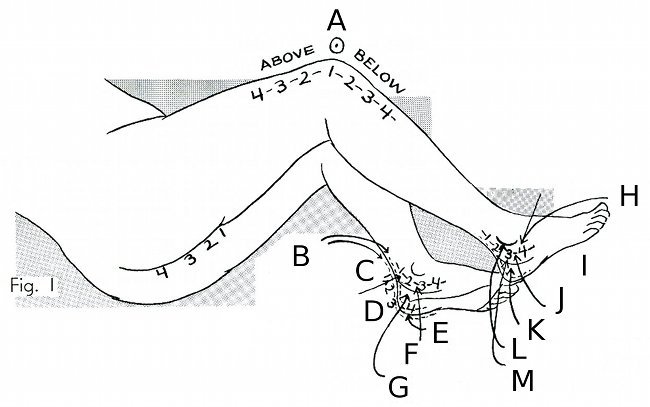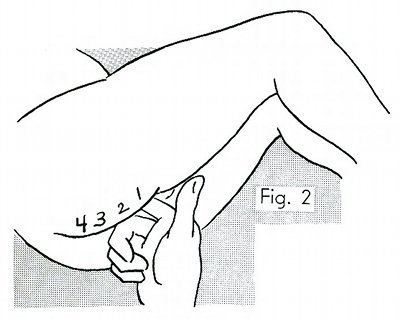|
Index of Transcribed Charts
Supplemental Essays
Contact Us
Acknowledgements
"Bumper Sticker" Quotes
Support DigitalDrStone!This site is a free service for Polarity Therapy practitioners, students and teachers, with the intention of expanding Polarity Therapy by making it more accessible. It is owned and operated by a non-profit organization, EnergySchool Foundation, with the support and permission of numerous other individuals and corporations as described in the Acknowledgements section. Please consider making a tax-deductible donation to support our continued presence by using this Paypal button to send a contribution.
Winner of the APTA "Outstanding Service Award" 2012
|
Polarity Therapy Volume 1, Book 2
Chart No. 31 - Perineal Therapy in Connection with Knees and Ankles.
|
Fig. 1 traces numbered reflex areas which correspond with each other. The perineal area around the anus reflexes functionally to the earthy triad of the abdomen and knees. Contacts here are useful in all digestive disturbances. In pregnancy and all leg trouble this technique is a revelation in its far reaching effect.
The area immediately around the outside of the ankle is an airy and glandular functional reflex. Its use is indicated in glandular disturbance and kidney condition. Any puffiness here is a kidney symptom. The heels are pelvic, generative and emotional reflexes. In pregnancy, great relief can be obtained by releasing the spasm of the inter-pelvic muscles which often affect the legs severely. In addition venous stasis is released by this relaxation, nervous tension balanced, and circulation improved because of the energy block release.
|

|
(A) Digestive reflexes, umbilicus
(B) Posterior reflexes around the inside maleoli [malleoli]
(C) 5th L [fifth lumbar, L5]
(D) Sacrum
(E) Coccyx
| (F) Womb, prostate
(G) Rectum
(H) Pelvic reflexes
(I) Around the outside maleoli [malleoli]
| (J) Ovaries, testes and hips
(K) Psoas magnus [psoas major] and iliacus
(L) Kidneys
(M) Ileo caecal [ileocecal]
|
|
|
The doctor can also stand in front of the patient for a deeper contact area 1 and 2 specifically for prostatic, uterine and digestive reflexes; also to release the atlas and axis on the opposite side of the body. These are central regions and need steady and deep pressure impulses over spastic pelvic muscles near the pubic bone. Patient is on side with knees flexed high. The doctor reaches over the lower legs to make the contact on the perineum. The angle of the direction of force applied here is very important for specific results.
|

The first finger is used to locate the tense fibres [fibers] in the perineum, because it is negative and more sensitive. For perineal therapy application the second [middle] finger is used, because it is positive stronger and longer to make a better contact.
In making a tissue contact on the perineum for treatment, a half turn of the finger to the right takes up the loose tissue and gives the best result in a light contact which relaxes the body.
Fig. 2 shows a No. 1 perineal contact, superior and medial in direction; light at first, then heavier. When the tense and tender areas let go, the contact is slowly released. Any two numbered areas may be treated against each other to release soreness caused by energy block. Posteriorly, the achili [Achilles] tendons are reflexes to the lower lumbar region. The os calcis [calcaneus] bones are reflexes for the sacrum and coccyx. In lumbago and lower back pain, it is very important to release the negative energy block here. These external areas are manipulated or held by heavy pressure, if it can be tolerated. Deep directional pressure held steady acts like the accumulated water that breaks the dam more completely than a lightning stroke or an adjustment.
|

Fig. 3 shows the combination of perineal and heel contacts for emotional tension, and for leg trouble, especially in pregnancy.
(A) Womb, prostrate, bladder contact
|
|
Illustration Keywords: above, below, 1, 2, 3, 4
|
|
Book 2, Chart 30 ~ Book 2, Chart 32
|
|
|
American Polarity Therapy Association
Copyright 2012 EnergySchool Foundation
Text & images from Randolph Stone, Polarity Therapy Vol. I & Vol. II, CRCS PO Box 1460, Sebastopol, CA 95473
Thanks to the American Polarity Therapy Association and CRCS Publications for supporting this project.
|